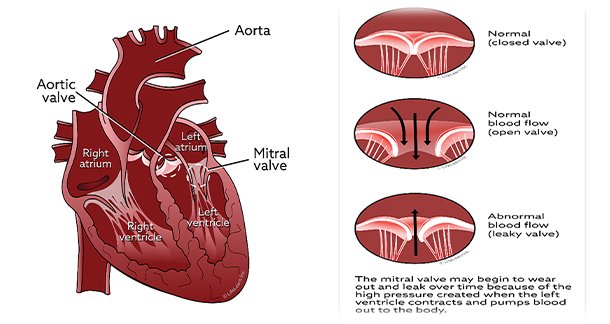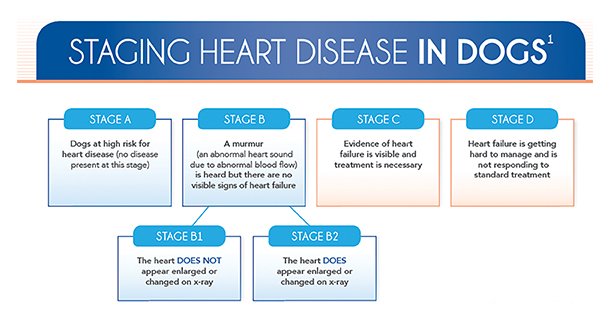Heart disease is a common and serious health issue in dogs, particularly as they age. It can affect the heart’s structure or function, leading to reduced quality of life and potentially life-threatening complications. Cardiac diseases in dog are complex, devastating and considered as a silent killer. According to the American Veterinary Medical Association (AVMA), one in ten dogs suffer from heart disease. Congestive heart failure (CHF) is a common clinical syndrome that results from a variety of disease processes in dogs. CHF is a condition in which fluid builds up (congests) in the lungs and other tissues due to the heart’s reduced ability to pump blood efficiently throughout the body. The most common causes of CHF include:
Dilated Cardiomyopathy (DCM)
Dilated cardiomyopathy is a heart disease causes heart muscle (myocardium) to become weaken results into the decrease ability of heart to pump blood through the vascular system which ultimately causes abnormal heartbeat (arrythmia). DCM most commonly affect the left sided chambers, particularly left ventricle but it can also affect right sided chambers or both the chamber simultaneously. DCM is more common in large breed as well as aged dogs and rarely affect smaller breeds of dog.
Dog DCM comes in two primary forms. The first results in weakening of the heart muscles which causes blood back up into the chambers and then the heart chamber enlarge and dilate. The second type results in irregular heartbeats.
Degenerative Mitral Valve Disease (DMVD)
The mitral valve, which resembles a one-way flap, permits blood to move from the heart’s upper left chamber (left atrium) to its lower left chamber (left ventricle). The function of the mitral valve is to prevent the (reverse) flow of blood from the left lower chamber to the upper chamber.
Degenerative mitral valve disease is also known as Myxomatous mitral valve disease (MMVD), mitral insufficiency, (andendocardiosis) is the most common cardiac condition occurs when the valve undergoes a degenerative change, thickening and becoming floppier and it is associated with a heart murmur. It is mostly, but not exclusively, a disease of smaller breed dogs and is seen in middle-aged or geriatric dogs. The cause of DMVD is still unknown, but in some breeds genetic or inherited factors are suspected to be a cause of the condition. It is observed that near about 80 % of heart diseases in dog is due to mitral valve insufficiency. The breeds more prone to these conditions include cocker spaniel, Cavalier King Charles Spaniel, Chihuahua, miniature schnauzer, miniature poodle, fox terrier, toy poodle, Pomeranian and dachshund. It is most commonly seen in male than female dog.
The other causes of CHF in dogs include defects in the walls of the heart, congenital defects, accumulation of fluid in the sac around the heart, Heartworm infestation, arrhythmias, increased blood pressure, endocarditis, tumor etc.
The American College of Veterinary Internal Medicine (ACVIM) consensus statement describes 4 stages of heart disease and failure. The ACVIM consensus statement for DMVD outlines a staging system for preclinical (stage B) and clinical (stages C and D) disease-
Symptoms of cardiac diseases
- Coughing (often nocturnal)
- Fatigue or exercise intolerance
- Difficulty breathing
- Fainting or collapsing
- Loss of appetite or weight loss
- Swelling in abdominal area
Diagnosis:
Various diagnostic tools for the diagnosis of heart disease include clinical examination and auscultation, radiography, electrocardiography, echocardiography and cardiac biomarkers (Nakayama et al., 2001). Auscultation is most helpful part of cardiac examination to detect abnormal rhythms and cardiac sound. The clinical signs of heart disease depend on the type of disease and severity and initially it is asymptomatic. As heart disease progresses to congestive heart failure, which occurs when the heart is unable to meet the circulatory demand, a dog may develop more obvious symptoms such as fatigue, reduced willingness to walk or exercise, difficulty breathing, loss of appetite, weight loss, a distended abdomen, trouble sleeping or coughing (MacPete, 2018).

Treatment & Management of cardiac Disease:
Early detection and proper treatment—ranging from medication to lifestyle adjustments—can greatly enhance a dog’s comfort and longevity. Managing heart disease in dogs requires a comprehensive approach that may include medications, dietary changes, and, in certain cases, surgical intervention. Medications are used to support heart function, minimize fluid retention, and regulate heart rhythm. Dietary adjustments—such as reducing sodium levels and providing sufficient protein are also essential components of effective heart disease management. The standard treatment of CHF in dogs consisting of a combination of the diuretic furosemide, an angiotensin-converting enzyme (ACE) inhibitor (ACEI), and Pimobendan.
- Pimobendan:
Pimobendan, is one of the most commonly used drugs for congestive heart failure, has been shown to improve the quality of life and survival times in dogs with the disease. Pimobendan is a positive inotrope and increases contractility through a mechanism different from that of traditional inotropes such as digoxin, the advantage of which is increased contractility without significant increases in myocardial oxygen demand. It relaxes vascular smooth muscle and elicits modest arterial vasodilation; this dual “inodilating” action is unique. Pimobendan is labelled for use in dogs to manage congestive heart failure (CHF) resulting from dilated cardiomyopathy (DCM) or degenerative mitral valve disease (DMVD).
Research data with preclinical DCM show that Pimobendan use was associated with
- Reduced left ventricular size in systole and diastole
- Delayed average time to onset of CHF or sudden death
- Longer overall survival times
Pimobendan added to heart failure therapy (with benazepril) improves clinical status, delays onset of refractory signs of heart failure, and increases survival times.
Pimobendan delays the onset of CHF, in part through reduction in heart size, and increases survival times. Its use is recommended for dogs that have a confirmed diagnosis of preclinical DMVD and radiographic and echocardiographic heart size measurements.
Study reveals that treatment with Pimobendan is effective for dogs with stage B2 (Preclinical Dilated Cardiomyopathy or Degenerative Mitral Valve Disease) or stages C and D (clinical DMVD) with or without pulmonary hypertension, characterized by elevated left atrial pressures. In dogs with concurrent pulmonary hypertension secondary to DMVD, the positive effects are probably multifactorial. The effects may be secondary to reduced left atrial pressure, increased right heart systolic function associated with increased inotropy, and reduced pulmonary vascular resistance associated with vasodilation.
Mechanisms of Action
Increased Cardiac Contractility: The positive inotropic effects of Pimobendan are mediated through a combination of 1) increased cyclic adenosine monophosphate mediated by phosphodiesterase III (PDEIII) inhibition, and 2) sensitization of the cardiac contractile apparatus to intracellular calcium. Calcium sensitization results in a positive inotropic effect without increasing myocardial oxygen demand.
Vasodilation: Balanced vasodilatory effects are mediated predominately through PDEIII inhibition in arterial and venous vascular smooth muscle. Additional endothelial-mediated vasodilation mechanisms may also contribute to this action and may be linked to the medication’s beneficial effect in the treatment of pulmonary hypertension.
Anticoagulation and Other Properties: In platelets, PDEIII inhibition mediates antithrombotic properties, leading to reduced platelet aggregation. This effect has been investigated in other pyridazinone – based compounds as well as Pimobendan. In a study of healthy dogs, Pimobendan mildly inhibited platelet aggregation but at a concentration well above a clinically relevant dose. In mice in heart failure, Pimobendan reduced some of the adverse cytokine concentrations.
- Benazepril:
A mainstay in the treatment of congestive heart failure (CHF) in dogs is the use of angiotensin-converting enzyme (ACE) inhibitors, such as benazepril. These drugs act by inhibiting the renin–angiotensin–aldosterone system (RAAS), a neurohormonal pathway that is activated in response to reduced renal blood flow and aims to maintain intravascular volume and perfusion during periods of diminished cardiac output. In dogs with CHF, Benazepril has been shown to enhance quality of life and extend survival. They help lower blood pressure, improve cardiac output, and decrease regurgitant blood flow resulting from valvular insufficiency (Oyama, 2009). By suppressing RAAS activity, benazepril reduces cardiovascular strain and promotes better heart function. Additionally, benazepril has been found to be well tolerated for long-term use in dogs with CHF, with minimal adverse effects reported.

- Combination of Pimobendan and Benazepril:
To enhance therapeutic efficacy, improve treatment compliance, and simplify administration, a fixed-dose combination of benazepril and Pimobendan has been developed. Pimobendan is an inotropic agent that strengthens heart muscle contractions and dilates blood vessels, thereby reducing cardiac workload. Benazepril, a prodrug converted to its active form benazeprilat in the body, acts as an ACE (angiotensin-converting enzyme) inhibitor. By decreasing the production of angiotensin II—a potent vasoconstrictor—benazepril promotes vasodilation, lowers blood pressure, and eases the heart’s workload. While both drugs are individually approved for use in dogs, their combined use leverages their complementary mechanisms: benazepril reduces angiotensin II and aldosterone levels, while Pimobendan exerts dual effects—vasodilation via phosphodiesterase III inhibition and enhanced cardiac contractility through calcium sensitization. Clinical data indicate that the safety profile of the combination at recommended doses is comparable to that of each drug administered separately.
- Formulation and Dosing
The combination product of Pimobendan and Benazepril should only be used in dogs which require both active substances to be administered concomitantly at this fixed dose. The recommended dose range is 0.25–0.5 mg Pimobendan per kg bw and 0.5–1 mg benazepril hydrochloride per kg bw divided into two daily doses. It should be administered orally, twice daily 12 hours apart (morning and evening) and approximately 1 hour before feeding.
Conclusion: Heart conditions like mitral valve disease, dilated cardiomyopathy or CHF in dogs are not uncommon and can greatly impact their quality of life. However, with the use of medications such as Pimobendan plus benazepril, these conditions can be effectively managed and allow pet to live a comfortable life. Pimobendan enhances heart muscle contraction and dilates blood vessels, while Benazepril reduces blood pressure and the workload on the heart. One of the great things about Pimobendan plus benazepril is that it has a high safety profile and can be used for long-term management of heart conditions. However, it is essential to note that these medications should only be used under the guidance of a veterinarian.
About Author
Dr. Jyotika Sangale, Dr. D J Kalita
Technical & Regulatory
Zenex Animal Health India Pvt Ltd
